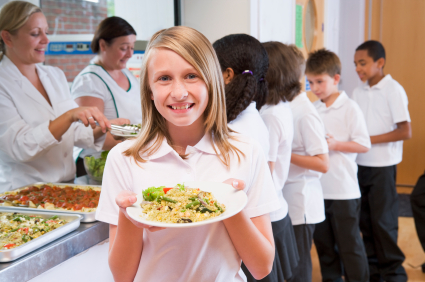 During a busy lunch period, time is students’ most valuable commodity and they will often grab a snack or skip lunch altogether rather than wait in a long line for a full meal, even when they are hungry! Worse, over 70% of students surveyed said long lines were a problem at their school! Hungry, time-pressed students are more likely to order foods that take little time to serve/take. Use this “how to” sheet to give healthy reimbursable meals and snacks an advantage—and improve National School Lunch Program (NSLP) participation too.
During a busy lunch period, time is students’ most valuable commodity and they will often grab a snack or skip lunch altogether rather than wait in a long line for a full meal, even when they are hungry! Worse, over 70% of students surveyed said long lines were a problem at their school! Hungry, time-pressed students are more likely to order foods that take little time to serve/take. Use this “how to” sheet to give healthy reimbursable meals and snacks an advantage—and improve National School Lunch Program (NSLP) participation too.
- Convert one line or window to healthy-items-only service. Stock with a variety of snacks and entrée options, with the focus on being as quick-service (grab-and-go) as possiblle
- Entrées: offer sandwiches/subs, prepackaged salads, yogurt parfaits (yogurt with fruit and nuts), and bagged lunches. Also, offer the lowest-fat/lowest-sodium entrée if possible (temperature rules may or may not allow this, depending on your lunchroom facilities)
- Drinks: milk, juice, and water
- Snacks/Sides: finger-food sides (raw veggie packs, whole fruits, and/or sliced fruits in bags or cups)
- Advertise! Create an attractive, brightly-colored sign about the line or window
- Emphasize the time savings: “Short on time? Pick this line! Sandwiches and salads are Grab-and-Go!”
- Emphasize that students can get full reimbursable meals at the window
- Important note: Do not use the word “healthy” in your sign – curiously, our research has shown that giving a food the title “healthy” actually decreases its sales. Better options are “Fresh Bites,” “Fresh Express,” “Fast & Fresh,” etc.
- Offer less-healthy snacks in regular lines only
- Cover ice cream freezer with paper (no transparent top)
- Place snacks on a rack behind the counter or on the back wall, where students must ask for them
- Offer snacks only after meal service is finished
- Instead of offering deals that encourage students to buy many snacks (for example, a 3-for-$1 cookie discount), “bundle” indulgent snacks with healthy partner foods (for example, a one-cookie-and-milk discount)
Contributor
Katherine Baildon- Cornell Center For Behavioral Economics in Child Nutrition Programs
For More Information
Check out this free for credit course offered by the Smarter Lunchrooms Movement
Source
“Create a healthy-items-only convenience….” Cornell Center for Behavioral Economics in Child Nutrition Programs’ Smarter Lunchroom Movement
Printable Version
